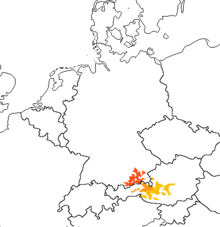Alpian languages
| Alpian languages | |
|---|---|
| dà Alwedülg | |
| Created by | Raistas |
| Setting | parallel Earth |
| Native to | Austria and Germany |
| Ethnicity | Baaye (de Baachen) and Vaand (dà Väänen) peoples |
| Native speakers | 310 000 ({{{date}}}) |
Oronaic
| |
Early form | Proto-Alpian
|
| Official status | |
Official language in | Austria (Salzburg and Carinthia); Germany (Upper Bavaria. |
Distribution of the Alpian languages:
Baaye
Northern Vaand (Fölvaand)
Vaand | |
The Alpian languages are spoken in the area of the Alps, in Austria and Bavaria, by approximately 310,000 people altogether. They derive from a common ancestral language called Proto-Alpian, and form a branch of the Oronaic language family. The branch consists of two living languages: Baaye and Vaand, which share a fair amount of mutual intelligibility between each other.
Classification
The languages are traditionally divided into Western and South-Eastern groups, which are geographic rather than genealogical groupings.
- Western (areal)
- †West Alpian (Schawardülg)
- Central Alpian
- Baaye
- Vaand
- Northern Vaand (Fölvaand)
- †Southern Vaand (Halvaand)
- Eastern Vaand (Edevaand)
- South-Eastern (areal)
- †Estric
- †Esterixic
- †Noroeic
Genealogically Western branch diverged first with a common sound change (*ï>*a, *e>*ä merge and raise of *ë to a new *ï) while *ë,ï>i merge is established for Noroeic. West Alpian is known only by placenames, since it left no written records and went extinct in the VIth century AD; it was more closely related to modern Alpian languages, than to the South-Eastern branch. Esterixian could have been a dialect of Estrian or it was a different name for the same language, and very little is known about these two. Some scholars believe Esterixian to have been an ancient Carpathian language or an intermediate language between the Alpian and the Carpathian branches. On the other hand, some sentences were documented in Noroeic during the Ist and IInd centuries CE and point to the language belonged to the Alpian languages, possibly related to Estrian.
